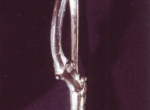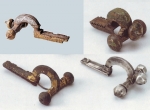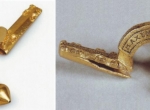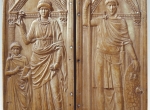Zwiebelknopffibel
The Zwiebelknopf fibula (a brooch with onion-shaped terminals), a Late Antique form; its prototype was the Scharnierarmfibel, a brooche in a hinged design (fig. 1). The earliest Z. brooches date to the 260s, the latest are present in assemblages from the second third of the 5th century.
The Z. brooch was worn by Roman soldiers and officials. Most often it was made of brass or bronze, it could be gilt, decorated with enamel or niello; some specimens are in silver (fig. 2) or gold (fig. 3). These differences (the use of precious metals, ornamentation) presumably resulted from social status of their owner. A gold Z. brooch was found in the tomb of Childeric, king of the →Franks .
Some of the gold Z. brooches belong to the Imperial group (German Kaiserfibeln), presented to merited officers or officials by the emperor himself, or on his behalf, starting from the time of the Tetrarchy. Many of these specimens feature the emperor’s name (fig. 3) making it possible to narrowly date the time of their execution.
Z. brooches are represented in some portraits – for instance, on the right shoulder of Stilicho, the commander-in-chief of the Roman army (magister utriusque militiae), son of a Roman woman and a Vandal, husband to Serena, family member of the Eastern Roman Emperor. These depictions confirm the use of Z. brooches by Roman dignitaries (fig. 4).
Literature: R. Noll, Eine goldene Kaiserfibel aus Niederemmel vom Jahre 316, Bonner Jahrbuch 174, 1974, p. 221-244; Ph. M. Pröttel, Zur Chronologie der Zwiebelknopffibel, Jahrbuch des Römisch-Germanischen Zentralmuseums Mainz 35, 1988, p. 347-372; Zwiebelknopffibel. [in:] H. Bech (Ed.) Reallexikon der Germanischen Altertumskunde, tom 34, Berlin, New York 2007, p. 605-623 (H. Steuer).
-
 full resolution
full resolution
Fig. 1. Prototype of the Zwiebelknopf fibula (M. Kemkes, J. Scheuerbrandt, N. Willburger, Am Rande des Imperiums. Der Limes – Grenze Roms zu den Barbaren, Stuttgart 2002)
-
 full resolution
full resolution
Fig. 2. The fibulas made of various metals (M. Kemkes, Von Augustus bis Attila. Leben am ungarischen Donaulimes, Konstanz 2001; T. Schmidts, Römer zwischen Alpen und Nordmeer, Mainz 2000)
-
 full resolution
full resolution
Fig.3. Zwiebelknopf fibulas, to the right so colled Kaiserfibel ((J. Frings, H. Willinghöfer, Rom und die Barbaren. Europa zur Zeit der Völkerwanderung, Bonn 2008, T. Schmidts, Römer zwischen Alpen und Nordmeer, Mainz 2000)
-
 full resolution
full resolution
Fig. 4. Diptich of Stilicho and his family (J. Frings, H. Willinghöfer, Rom und die Barbaren. Europa zur Zeit der Völkerwanderung, Bonn 2008)


